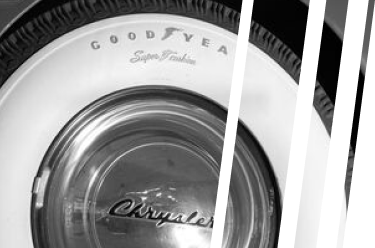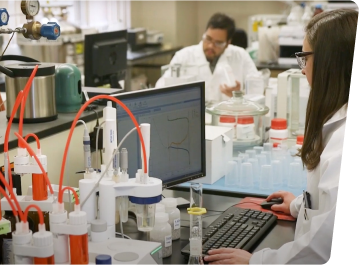Company / History

History
For more than 125 years, Goodyear has kept the world moving.

OUR FOUNDER:
F.A. “Frank” Seiberling
In 1898, F.A. “Frank” Seiberling traveled to Chicago on business and came away as the owner of two empty factories on Market Street in Akron, Ohio. The 38-year-old had no idea how he would use them, but he and his brother C.W. “Charley” Seiberling soon began making rubber products, such as horseshoe pads, poker chips and carriage and bicycle tires. Little did the brothers know that the coming adoption of the automobile would lead to their start-up company becoming a powerful global brand.

OUR INSPIRATION:
Charles Goodyear
The Seiberlings were inspired by the spirit of discovery embodied by chemist, engineer and inventor Charles Goodyear. In 1839, Goodyear discovered that when a mixture of “gum elastic” – natural rubber – and sulfur were exposed to heat, the compound became pliable, resilient and durable. This process was subsequently called “vulcanization” and opened the door to the manufacture of rubber products such as tires.

OUR HOME:
Akron, Ohio, USA
In addition to Akron being the home of the Seiberling brothers, the manufacturing town of 50,000 was already base of other rubber companies in 1898. It had a reliable workforce already in place and was located near the Little Cuyahoga River and the B&O Railroad line, which would make for convenient shipping of materials. As the company grew, so did Akron, which eventually became known as the “Rubber Capital of the World.”
Did You Know?
Early automobile tires were difficult to both mount and remove from a wheel, requiring a crowbar, muscle and patience. In 1901, Goodyear introduced its solution – a straight-sided tire that didn’t have to curve inward to stay attached to the rim. By using an innovative braided wire bead, the tire stayed firmly attached in use, was easily removed for maintenance and offered a more comfortable ride. The breakthrough tire was a critical product for Goodyear, the fledgling automobile and the future of transportation.

Brands
Drivers around the world have come to trust Goodyear tires for their quality, dependability and value. The company’s commitment to earning the trust of drivers everywhere comes through in its other brands as well, such as Kelly and Dunlop. In Europe, Goodyear makes and sells tires under the Sava, Debica and Fulda brands, and in 2021, the company acquired Cooper Tire and its family of brands.
1935: Kelly Tires becomes a sister brand
1962: Fulda and Metal Wheel Company acquired
1995: Majority control of TC Debica acquired
1999: Dunlop added to the portfolio through a joint venture
2021: Cooper Tire becomes companies largest acquisition

Icons
Central to Goodyear’s corporate logo is the winged foot of Mercury. Founder F.A. Seiberling was inspired by a statuette of the Roman deity which was the “messenger of the gods” and was the patron of such things as travel and commerce. Perhaps no corporate icon is as well-known as the Goodyear Blimp. The company began building airships for the military during WWI and in 1925, began producing blimps for its marketing efforts. Since then, more than 300 Goodyear Blimps have adorned the skies around the world.

Racing
In the early 1900s, Henry Ford wanted to test his automobiles by racing, so his first call was to Goodyear. Since then, the company’s tires have been in the winner’s circle in almost every form of racing imaginable – from NASCAR and IndyCar to the Dakar Rally and the 24 Hours of LeMans. The racetrack provides the perfect testing ground for innovation, as many of the developments in racing tires have been adapted for passenger vehicles across the globe.
Did You Know?
One way Goodyear tires became synonymous with speed was its role in the pursuit of the world land speed record. In 1960, Mickey Thompson broke the 400-mph barrier at Bonneville Salt Flats on Goodyear tires. Four years later, Craig Breedlove reset the mark by going 526.28 mph in a jet-powered Spirit of America equipped with Goodyear tires. In 1965, Breedlove eclipsed 600 mph, again riding on Goodyear.

The War Years
Goodyear converted much of its tire manufacturing to production of items to support war efforts. Bullet-proof fuel tanks, gas masks, rubber rafts and the like were built by women, retirees and others who were not on active duty. During WWII, Goodyear’s aviation division built the nimble Corsair aircraft as well as engines and guidance systems. During the 1940s, Goodyear and other tire companies collaborated on the rapid development of synthetic rubber, which became a critical component of product beyond tires in the decades that followed.

The Space Age
With the expansion of space exploration, Goodyear’s scientists were responsible for the development of satellites, antennae, guidance systems and more. One of its most important innovations was a computer called STARAN, which had the world’s first content-addressable memory, which we now call a “search engine.” Goodyear played a role in space exploration as well, making fabric flotation devices used to recover spacecraft and astronauts returning to earth.

Polymers
Goodyear’s scientists led the development of such products as plastics and foam, film and flooring, hoses and belts and latex items for industries as diverse as medical and food service. In 1976, a polymer developed in Goodyear’s lab was used as the membrane for an artificial heart built in collaboration with the Cleveland Clinic. That technology enabled other breakthroughs in artificial hearts, which have saved and prolonged many lives.
Did You Know?
Goodyear’s experience with “lighter than air” blimps opened the door for the company to produce a different kind of inflatable. From 1928 through 1980, Goodyear created the popular balloons for the Macy’s Thanksgiving Day Parade in New York City. The company was responsible for more than 100 balloons, including such popular characters as Superman, Mickey Mouse and Snoopy.

Tires
Goodyear’s innovative tires have been industry leaders for more than 125 years. The company introduced the first “all-weather” tire, sent tires to the moon and claims the winningest racing tires around the world. Throughout its history, Goodyear has enhanced mobility from streets and highways to farms and work sites…and even in the skies. It has developed tires that improve traction on slippery roads, maximize fuel economy and continue to run even when flat.

Science
Goodyear’s scientists, engineers and researchers have continually discovered new solutions and opportunities for changing mobility needs. For example, polymer research led to the development of synthetic rubber for use in tires and beyond. Material science unearthed new components to enhance performance and durability. And new technology was applied to tire design and enabled virtual tire testing.

Business
Goodyear is more than a tire manufacturer. Since its founding, Goodyear has evolved to become a technology-driven company that enables mobility. Along the way, it also has innovated its business models, expanded its manufacturing and sales and even became the first tire brand to sell directly to consumers online. More breakthroughs, such as mobile tire installation, are setting the pace for the industry for the next 125 years.
Did You Know?
In 1908, Goodyear established its first “Development Department,” organizing the company’s research, development and testing processes to be more scientific. That year, Goodyear also launched the first all-weather tread design, featuring diamond-shaped blocks to resist skidding. The breakthrough tread pattern became the company’s best known and would be its leading design into the 1940s.

New Tires
Goodyear already makes tires with sustainable components, tires specifically for electric vehicles and even airless tires. Can spherical tires or tires that double as propellers be far behind?

New Technology
As vehicles become autonomous, electric, connected and sustainable, Goodyear’s products will become part of a complete integrated vehicle operating system, with sensors to gather and provide data, making transportation safer and more efficient. But that’s just the beginning.

New Services
New shared, personal and commercial vehicles will require a support infrastructure of new services. Goodyear’s SightLine suite of technologies and AndGo platform are examples of the variety of support services the company will deliver to maintain and operate fleets of all kinds.
Did You Know?
In 2020, Goodyear launched a venture capital fund – Goodyear Ventures – to expand the company’s growing relationships in new mobility. The fund now works with startups developing breakthrough solutions in material science.